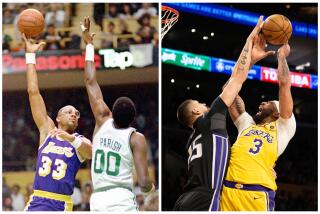Abdul-Jabbar embraces role of Renaissance man
- Share via
Our image of Kareem Abdul-Jabbar, although a good one, is outdated.
We still have him frozen in mid-skyhook, his No. 33 as memorable as the grace of his shooting motion.
The current image should be of a still-shy man, now 60 years old, hunched over a computer keyboard, pulling words from a mind that has long played second fiddle to a 7-foot-2 body and a pro basketball career that will never be replicated.
The leading scorer in the history of the National Basketball Assn. has become a leading historian and author. His sixth book, “On the Shoulders of Giants,” is his most recent journey into the past of black America. Kareem Abdul-Jabbar now pursues his heritage with the same fervor he once pursued scoring records.
“I played basketball for 40 years of my life,” he says, “but it never defined me.”
Already, “On the Shoulders of Giants” has gone a long way toward doing that.
It is a book about the Harlem Rens, a black basketball team of the 1930s that Abdul-Jabbar uses to open a window to black America of the day.
Author Edward Doherty called Harlem in the ‘30s “the colored city in the greatest metropolis of the white man.” A saying of the day, author unknown, was, “I’d rather be a lamppost in Harlem than governor of Georgia.”
The Rens were named for, and sponsored by, the Harlem Renaissance casino and nightclub. They played at a time of whites-only pro basketball, when the most famous black team was the Harlem Globetrotters.
The coach and visionary of the Rens, Bob Douglas, created the team as the antithesis of the Globetrotters, whom Abe Saperstein had made into a sort of collection of Stepin Fetchits, fun and non-threatening to the white folks who bought the tickets. That the Globetrotters were great basketball players was almost secondary to how entertaining they were; thus the dashes into the crowd with water buckets full of confetti.
Also, the Globetrotters were from Chicago, not Harlem.
Douglas’ Rens, who barnstormed the country like the Globetrotters, were serious, competitive and better stood for what was really going on in Harlem at the time. It was a time when African Americans were determined to change how white America viewed them.
In an audio CD about the book, Abdul-Jabbar keynotes the way it was for blacks in the 1930s. When German Max Schmeling fought Joe Louis in a heavyweight title bout, one of the songs played at ringside was “All Coons Look Alike.” When Schmeling knocked out Louis, the New Orleans Times-Picayune reported that the result “proved which is still the master race.”
Abdul-Jabbar interviews famed poet Maya Angelou, who says she cried tears of joy when Louis won the rematch with a knockout in the first round.
The showcase moment for the Rens, and the book, occurs in March 1939. For the first time, the Rens were invited to play in the World Professional Basketball Tournament, a 12-team, invitation-only event at the Chicago Coliseum. It was a first-ever opportunity for an all-black pro team to compete with the perceived-to-be-superior white teams.
In the field were the white powerhouses -- the New York Yankees and New York Celtics, as well as the Oshkosh All-Stars and the Sheboygan Redskins. Also in the field, and interestingly in the same bracket as the Rens, were the Globetrotters. Racial equality appeared to fall just short of allowing an all-black final.
The Rens beat the Globetrotters in the semifinals and the Oshkosh All-Stars in the final. In a small but significant way, the Harlem Rens had changed the way white America viewed them.
“On the Shoulders of Giants” also changes the way we might think of its author. In the CD, Abdul-Jabbar explains how a happy child changed after being sent to a boarding school near Philadelphia for fourth grade and becoming the target of bullies. He became withdrawn and decided that was how he would conduct himself from then on, an approach that later got him labeled as sullen and uncooperative with the media. He now explains that as shyness more than unfriendliness, as a childhood scar that has never healed.
He didn’t even know the Rens existed until he was inducted into the Hall of Fame in 1995, six years after he retired from the Lakers, and started to pay more attention to his sport’s heritage. That played directly to a real affection.
“I loved school, loved UCLA,” Abdul-Jabbar says. “I remember, in an English class taught by a Mr. Lindstrom, we were asked to do essays and he said he would read the best three to the entire class. He read the first two, then said he was going to read the best one, and it was mine.
“It was right then that I thought maybe I could do this, that maybe I had what it takes.”
He also played at UCLA for John Wooden, always more English teacher than coach.
“We’d sit on the bus and talk about when to use a colon and when a semicolon,” Abdul-Jabbar says. “We’d argue the difference between “like” and “as if.”
The next stage for “On the Shoulders of Giants” will be acquiring the right telecast partner for a nearly completed documentary. Then, it will be on to the next book for Abdul-Jabbar, who wants to tell the real story of Wild Bill Hickok, better known as a lawman gunslinger than for helping slaves escape to Canada.
For years, Abdul-Jabbar appeared on covers of sports magazines all over the world. This month he appeared again, in blue suit and tie, on the cover of American Libraries.
It’s a new image. And the right one.
--
Bill Dwyre can be reached at bill.dwyre@latimes.com. To read previous columns by Dwyre, go to latimes.com/dwyre.
More to Read
Go beyond the scoreboard
Get the latest on L.A.'s teams in the daily Sports Report newsletter.
You may occasionally receive promotional content from the Los Angeles Times.











